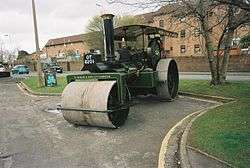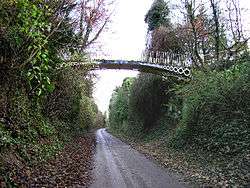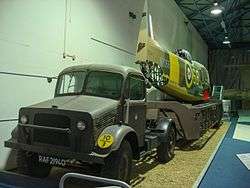Taskers of Andover

Taskers of Andover were an Andover, Hampshire based metal works and engineering company, which became better known in the latter half of the 20th century for their lorry trailers. After 170 years in operation, the company became first part of the John Brown company, and then sold to Montracon, where it was quietly closed.
Background
In 1806, Robert Tasker of Stanton St Bernard, Wiltshire travelled from his father's blacksmith business to Abbotts Ann, Hampshire to join the forge ironworks business of Thomas Maslen. In 1809, he took over the business, but due to his non conformist Christian views, Tasker found business hard, and was forced to bid for work from further afield.
Waterloo ironworks

In 1813, Tasker and his brother William founded the Waterloo Ironworks in the Anna Valley. The site, built on chalk strata, gave access to coal and iron ore via the Andover Canal, and offered waterwheel power from the Pillhill Brook. The works came into operation in 1815, hence it is named after the great Battle of Waterloo. The brothers entered into a partnership with George Fowle, a relative of Robert's wife, Martha.[1]
The Swing riots
As the industrial revolution gathered pace, a series of riots began. Started in Kent by a Captain Swing, a group of 300 agricultural workers entered the works 20 November 1830, causing considerable damage. 30 men were arrested by Special constables, for which 14 were tried, 4 acquitted, and 10 eventually transported to penal colonies in Australia.
William's sons take over
After the opening of the London and Southampton Railway, the canal was closed, and eventually buried to make way for another railway line, which hence replaced Taskers wharf with a series of private railway sidings. In 1857, two of William's sons took over the business, coming to a licence agreement with Clayton & Shuttleworth of Lincoln to sell and service their stationary boilers.
Steam engines
In 1865, the Waterloo Ironworks made its first steam engine, and until 1891 Taskers became known as a producer of bespoke steam engines, each one of which was produced to its own unique design. After William's third son Henry joined the firm, he implemented the "Economic" design of 8 horsepower (6.0 kW) engines of 1891, which formed the first series of standards Tasker designs, using steel boiler plates over wrought iron.
Tasker & Sons
Henry, who was now running the business, bought out his brothers interests, but the company was now left short of capital, and hence struggled through to World War I. Henry found new capital via a series of share sales, which resulted in the 1902 development of the standard class of 'light' (just under 3 tonnes or 2.95 long tons or 3.31 short tons) engine called "Little Giant," of which over 300 were made.
After liquidation in 1903, and reformation in 1907, Taskers thrived in production in World War I. Post-war, Taskers built a series of road rollers, but the economic slump brought about a second inevitable receivership in 1926, and liquidation.

In 1932, the company was revived (as Taskers of Andover (1932) Limited) through the production of semi-trailers. Using steel over iron, the product didn't require the services of the Waterloo Ironworks, which closed permanently in 1937.
In 1938, the Air Ministry which was forming plans for the Civilian Repair Organisation, sent out a tender for a recovery trailer able to carry an entire fighter aircraft. 10 days later Taskers arrived in Whitehall not only with a written and costed proposal, but also with a prototype trailer. Subsequently nick named the Queen Mary trailer after the great RMS Queen Mary of the Cunard Line, the company gained 300 orders in the buildup to World War II.
Tasker Trailers
Adopting the post-war name of Tasker Trailers to supply the developing road transport industry, the company had branches in Wigan and Scotland. Taken over by Craven Industries, which later itself became part of the John Brown and Co engineering conglomerate, it was sold as part of a package of assets in 1983 to Montracon of Belfast, Northern Ireland. After the closure of the works and demolition of the residual buildings in 1984, Montracon decided to consolidate its brands, resulting in the end of the Tasker brand in the late 1990s.
Preservation
Several Tasker vehicles are preserved at Milestones Museum, Basingstoke, Hampshire.
References
- ↑ "Waterloo Ironworks, Taskers of Andover". .hants.gov.uk. 2012-05-23. Retrieved 2012-05-27.